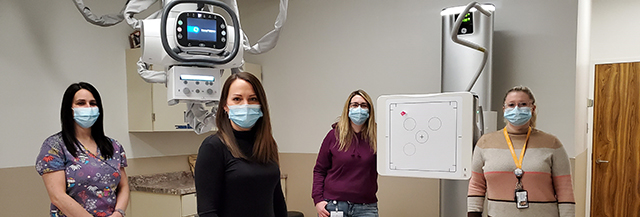Radiography (X-ray)
What we do
X-ray examinations are performed by medical radiation technologists who specialize in radiographic technique and application of a wide variety of imaging procedures.
For years, X-rays have been relied upon as a basic tool for the diagnosis of illness or injury. It is the most frequently used imaging method for visualizing the inside of the body.
Images are produced when radiation is passed through a part of the body. X-rays are used in most cases to diagnose such conditions as a chest infection or broken bones.
Fluoroscopy
Fluoroscopy, performed by technologists and radiologists, is an imaging technique that allows radiologists to view images in real-time. Radiologists can use fluoroscopy to visualize blood vessels and internal organs as they work. It is used to perform barium enemas (bowel X-rays), upper GI series (stomach X-rays) or to guide procedures such as angioplasty or lung biopsy.
Contrast studies
Contrast studies use contrast or dye such as barium, water, iodine and air, to visualize certain parts of the body. Barium, water, and air are used to visualize the colon or bowels and the stomach. Iodine is used to image the kidneys, other organs and blood vessels.

What patients can expect
Fluoroscopic and X-ray procedures are generally painless and usually take less than 30 minutes. If patients have broken bones some discomfort during positioning may be experienced while the technologist positions the body to obtain the required images for diagnoses.
Some examples of fluoroscopic/X-ray tests include:
- All bone examinations, hands, feet, spine, head, etc.
- Chest and abdomen images.
- Examinations of the stomach and bowel (barium is used to visualize the organs).
How to access service
You will need to visit your physician who will determine if this is the best course of action for your condition. An examination can only be scheduled by a physician, chiropractor or nurse practitioner. Before your X-ray can be completed, your physician is required to provide a completed requisition.
Locations that offer this service
Please note:
- Patients are notified by telephone and/or appointment letter for all services that require an appointment.
How to Prepare
There is no preparation required for a routine X-ray examination. You may be asked to change into a gown and will be required to remove any jewelry or other metal objects that may appear on the X-ray image.
If your procedure requires the use of contrast (dye), instructions for preparation will be included in your appointment letter.
The doctor who ordered your examination may also give you information about the required preparation.
Some fluoroscopic procedures include:
- Barium Enema
- Upper GI series
- Barium Swallow
Test results
Your examination will be reported by a radiologist or nuclear medicine physician and sent to your doctor within 15 business days of your appointment.
Please check with your doctor’s office to find out if your report has been received.
Benefits
X-ray is a good method of imaging many parts of the body, especially bone, joints, chest, and abdomen. It is an excellent medical imaging test because it can provide a fast answer that will either immediately diagnose a condition or provide enough information to determine the next best course of action for the patient. This makes it very useful for emergency medicine.
Risks
As with all X-ray procedures, you will be exposed to a small amount of radiation. There is a very low risk associated with this exposure. Precautions are continually taken to minimize the amount of radiation necessary to complete the procedure.
Safety precautions
Please advise your doctor and the technologist performing the procedure of the following:
- Any possibility that you could be pregnant.
- Any allergies.
- Any allergic reactions you have had to anesthetic or X-ray contrast dyes.
- Any medications you are taking.
- History of asthma, heart, or kidney problems.
